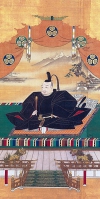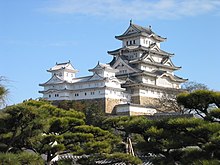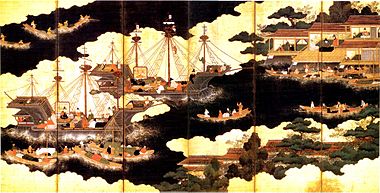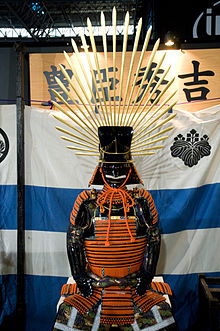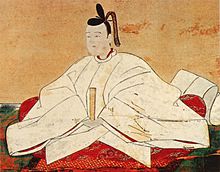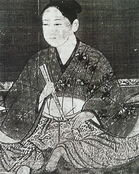| |
丰臣秀吉(日语:豊臣 秀吉〔豐臣 秀吉〕/とよとみ (の) ひでよし Toyotomi (no) Hideyoshi;1537年3月17日-1598年9月18日)是日本战国时代末期至安土桃山时代的大名,原姓木下,之后将丹羽长秀的羽字和柴田胜家的柴字各取一字将改姓羽柴。原为下级武士家庭出身,后来因事奉其主织田信长,富有才干而逐渐发迹,在主君织田信长死后,在内部斗争中胜出,于1582年的山崎之战击败明智光秀、于1583年的贱岳之战击败柴田胜家,篡夺织田家的家业,进成为织田信长实质的接班人。之后在1585年(天正十三年)担任关白,1586年(天正十四年)再兼任太政大臣等职位,获赐氏姓“丰臣”,并动工兴建大阪城,并透过不断征伐与收编各方势力,实现日本自15世纪中叶后首次的形式上的统一,是为丰臣政权,成为日本的最高统治者。掌权期间通过太阁检地、刀狩令等政策强化武士阶层,稳固其统治基础;晚年发动朝鲜之役,在战事末期逝世,被日本朝廷赐封“丰国大明神”。在日本历史上,丰臣秀吉与其同时代的主君织田信长、及其家臣德川家康并称“战国三杰”。
经历
青年时期
天文六年二月初六日(1537年3月17日) 丰臣秀吉出生于尾张国爱知郡中村(今爱知县名古屋市中村区),父为贫困农户木下弥右卫门,母亲是仲(日语:仲/なか Naka)。幼年时期取名为日吉丸(日语:日吉丸/ひよしまる Hiyoshi-maru),仕于织田信长成为武士之后改名木下藤吉郎(日语:木下 藤吉郎/きのした とうきちろう Kinoshita Tōkichirō)。
由于秀吉的出身并非显贵,有关于他早期的文献记载十分有限,仅大概知道他少年时曾在尾张、三河、骏河等地方活动,父亲曾在尾张地方国人众蜂须贺氏(蜂须贺正利)麾下当雇佣性质的杂兵,修理、锻造兵器。秀吉七岁父亲死亡,八岁母亲改嫁,只好出家,入光明寺当小沙弥,曾经在远江国引马城支城头陀寺城成为松下之纲[注 1]的部下,《太阁记》记载秀吉元服时由松下之纲为乌帽子亲并命名中村(的)秀吉,但离开原因不明。[注 2]后从远房姨妈伊都父亲清兵卫的锻冶屋拿针贩卖。
信长家臣时期
1554年(天文二十三年)以小者的身份成为了织田信长的家仆,[注 3],被信长唤为猿或秃鼠(禿げ鼠)[注 4],地位在足轻与“中间”之下,作为小者中的“草履取”[注 5]的等级,若随信长上阵,“中间”可以持胁差或木刀,小者只能帮主公提武具或充当“人夫”。后来因帮信长拿草鞋时将草鞋放进怀里暖鞋获得信长的欢心。1555年(弘治元年)陪同信长侧室生驹吉乃回娘家小折城的生驹屋敷,经吉乃介绍认识生驹氏亲戚蜂须贺正胜与川并众。[来源请求]1561年(永禄四年)与浅野长胜的养女(浅野长政的义妹)宁宁结婚,[注 6]更名为木下秀吉。[注 7]1570年信长准备进攻朝仓义景的中途,在金崎遭到盟友浅井长政攻击从后包抄,此战秀吉为殿后军一员,保护信长安全撤离(金崎之战)。
元龟元年(1570年)在姊川之战后,秀吉担任此役夺取的近江国横山城城代,并以此领地可动员的兵力一千人及在地情报,陆续在箕浦之战、横山城之战跟虎御前山之战中击败浅井军,天正元年(1573年)在小谷城之战从防御土垒最矮(约一米五)的中段京极丸,切断浅井父子俩的防守区域,因此信长击败了浅井长政,长政自尽,浅井的旧属归织田家所有,以此功秀吉支配(领有一小部分600贯约2400石~3000石)北近江三郡十二万石成为城主,将根据地移至近江国今滨城,利用小谷城的土石建材增建今滨城后易名为长滨城。后赐苗字“羽柴”(日语:羽柴/はしば Hashiba)。[注 8]
他同时也招募家臣,在封为城主前他底下的家臣就是蜂须贺正胜(与力)、竹中重治、前野长康(小六若党),尚未元服的福岛正则、加藤清正,一门众的浅野长政、羽柴秀长。而大谷吉继、石田三成等家臣,皆是出身于近江地侍小姓,增田长盛则出身尾张国中岛郡増田村,原为信长家臣后改寄骑羽柴秀吉。
1576年(天正四年)支援北陆柴田胜家对抗上杉军,但秀吉因为和胜家战略上意见不一而擅自撤离,致使胜家在手取川之战中大败,使胜家和信长有所不满。在织田信忠的指挥下,秀吉与佐久间信盛、明智光秀、丹羽长秀共同参与攻击松永久秀的战斗。
1577年(天正五年)赤松则房、别所长治、小寺政职臣从信长之下,秀吉受命攻略中国地方,任播磨国国主,并从播磨国进攻但马国,在岩洲城攻略时,成功降伏于竹田城笼城据守的太田垣辉延,此时根据地为小寺孝高(黑田孝高)让出的姬路城(中国征伐),受命后不久别所长治及荒木村重背叛织田信长,秀吉前往讨伐,致使中国征伐暂时停顿。1579年使备前国及美作国的大名宇喜多直家完全臣服于织田氏,同年迎立信长的四男于次丸(羽柴秀胜)为养子。1580年别所长治和荒木村重战败,别所长治切腹自尽(三木合战);荒木逃离,全家被信长诛杀,但这期间,包括竹中重治及古田重则等家臣阵亡。
秀吉开始与毛利氏及山名氏交战,攻陷山名祐丰笼城据守的有子山城,嫡男山名氏政于落城前归降羽柴家,秀吉自自专致于播磨的经营,任命弟弟羽柴秀长担任有子山城主,负责统治但马国。此外,收购鸟取周边的兵粮,用断粮战术攻下了鸟取城(鸟取城之战),毛利一族的吉川经家战败自杀,随后进军备中国,用水攻战术逼迫高松城开城(备中高松城之战),城主清水宗治自杀。
本能寺之变
1582年明智光秀于支援秀吉出兵毛利氏途中,发动背叛兵变,攻占京都并夜袭投宿在本能寺的织田信长,是为本能寺之变,信长于本能寺焚死,尸骨无获,其长子织田信忠于二条御所战败后切腹自尽。当时羽柴秀吉正亲自率兵包围备中国的高松城。由于黑田官兵卫用计水攻高松城,而使光秀向毛利氏报信的信使隔天在被水包围的城下被羽柴军所抓,所以秀吉在事变隔天便得知消息。秀吉向毛利氏隐瞒信长身亡的消息,透过毛利家外交僧安国寺惠琼与城主清水宗治斡旋。之后,在毛利氏大老小早川隆景主导下,他迅速与毛利氏议和,并率兵在五日内“强行军”约200公里返京,并随即与明智军展开决战,这次行军史称“中国大撤退(中国大返し)”,行动之迅速大大震撼了京都的明智军。回师之时,秀吉以“为信长公报仇”之名为号召,成功收拢各地的信长旧属,包括光秀的寄骑中川清秀及高山右近,于山崎之战击败准备不及、兵力处于劣势的明智光秀,最终明智光秀逃走时被猎杀落难武士的村民杀死,秀吉乘机控制京都一带,不过无法阻止织田氏内部出现派系分裂。主要分裂为柴田胜家、织田信雄、织田信孝以及羽柴秀吉等派系。
信长后继者
6月27日,织田旧臣在清洲城召开会议,讨论信长的后继者及遗领分配的会议(清洲会议)。织田家重臣柴田胜家拥戴信长的三男织田信孝(神户信孝,庶子),然而秀吉推举织田信忠仅三岁的嫡长子三法师(即织田秀信)。胜家虽然表示反对,但池田恒兴及丹羽长秀都支持秀吉,最后双方以信孝担任年幼的三法师的后见人等折衷方案,才获得胜家的首肯,但也因此得罪了柴田胜家,导致其拥立信长三子织田信孝对抗秀吉。
领地分配方面,织田信雄获得尾张国、织田信孝获得美浓国、织田信包获得北伊势及伊贺国、光秀的寄骑细川藤孝获得丹后国、筒井顺庆获得大和国、高山右近及中川清秀的本领获得安堵、丹羽长秀获得近江国滋贺郡、高岛郡15万石、池田恒兴获得摄津国尼崎及大坂15万石、堀秀政获得近江国佐和山。胜家获得原为秀吉领地的长滨12万石。秀吉自身则获得明智光秀的旧领丹波国及山城国、河内国28万石。
秀吉于山崎建筑宝寺城,并在山崎及丹波国实施检地,私底下也与织田家的诸大名缔结联谊、盟友,引起柴田胜家的不满,致使双方愈显对立。 天正10年(1582年)10月,胜家与泷川一益、织田信孝共同向诸大名发出弹劾秀吉的书状,指责秀吉违反清洲会议并私自建筑宝寺城。秀吉则在10月15日以养子羽柴秀胜(信长的四男)为丧主,在京都举办大规模的信长葬仪,由于未通知胜家,更引起胜家不满。柴田胜家派出的佐佐成政压制越中,上杉家鱼津城守将须田满亲只好与成政议和,退出鱼津城和小出城后,经海路退回越后,此外,胜家也与中国的毛利辉元联络,打算夹击秀吉;秀吉眼见与柴田胜家一战势所难免,于是联络越后的上杉景胜与美浓的稻叶一铁,并在中国地区的山阴配置宫部继润、山阳配置蜂须贺正胜,以防范毛利氏攻击。
12月,秀吉趁越前国胜家受阻于风雪无法动兵,以信孝挟持三法师不让其返回安土为借口,举兵进攻信孝。12月9日,秀吉向池田恒兴等诸大名发出动员令,自己也集结5万大军自宝寺城出阵,12月11日抵达堀秀政的佐和山城,进而包围柴田胜家养子柴田胜丰的长滨城,后来秀吉透过调略使其降伏,因而获得长滨城。12月16日进攻美浓国,降服稻叶一铁,并与织田信雄军合流,乘势进攻信孝的家老斋藤利尧防守的加治木城并顺利攻陷。于岐阜城孤立的信孝,不得已将三法师交给秀吉,并由生母坂氏及女儿担任人质,双方议和。
天正11年(1583年)1月,反秀吉派的泷川一益,击败秀吉方伊势国峰城的冈本良胜、关城及伊势龟山城的关盛信。秀吉于是在2月10日进攻北伊势,2月12日攻击泷川的居城桑名城,但由于桑名城十分坚固且泷川英勇抵抗,秀吉军撤退三里驻扎。之后,秀吉组织别动队进攻长岛城及中井城,但仍由于泷川的抵抗而败退。但伊势龟山城在蒲生氏乡、细川忠兴及山内一丰的攻击下,于3月3日降伏,此后,伊势战线秀吉方居于优势。
2月28日,胜家待融雪后,派前田利长担任先锋出阵,自己于3月9日率3万大军。秀吉则将北伊势交给蒲生氏乡后返回近江国,3月11日与柴田势对峙。但对峙期间,4月13日秀吉成功策反柴田胜丰的家臣山路正国,掌握了柴田军的布阵情形。织田信孝眼见机不可失,再度于岐阜举兵进攻稻叶一铁,此时胜家方取得优势。秀吉再度转向进攻信孝。
4月20日早上,胜家的重臣佐久间盛政趁著秀吉进攻织田信孝(美浓国)时发动奇袭,进攻大岩山砦的中川清秀,中川清秀败死,岩崎山砦的高山重友则大败而走。但之后盛政违抗胜家不得久留的命令,持续在城砦与秀吉军对峙,秀吉于4月21日回军进攻柴田方,柴田军由于前田利家的背叛而大败,柴田胜家撤回越前。
贱岳之战最终由秀吉取得胜利,胜家与妻子阿市于4月24日自杀,秀吉顺势平定加贺国、能登国,泷川一益也降伏而蛰居,织田信孝不久被迫自杀,留下诅咒秀吉之辞世句。自此秀吉彻底掌握旧主信长的江山。
天下人之路、让出家督
天正十二年,秀吉在石山本愿寺的旧址上建大坂城,当时到访的大友宗麟将它称为“战国无双的城”,但城堡在防御上亦有缺点,在大坂冬之阵中,真田信繁进行了修筑加强防御。
1584年,原先与秀吉合作的信长次男织田信雄联合信长的盟友德川家康反对秀吉,羽柴军便与两人展开史称小牧·长久手之战的战事。此战之初拥有兵力优势的羽柴军直扑德川领地,但途中却遭到德川军伏击,有“鬼武藏”之称的大将森长可与池田恒兴二人,被德川四天王的井伊直政所率领的重装精锐赤备骑马队所讨杀,秀吉其后撤兵,改为攻击美浓的织田信雄,信雄投降,迫使双方谈和,德川军与羽柴军达成和战协议。
1585年,秀吉派遣其弟秀长、与毛利元就三男小早川隆景等将领攻打刚统一四国的长宗我部氏,落后的四国与丰臣军实力差距过大惨败归降并减封至只剩土佐一国。此外秀吉派遣藤堂高虎为首的部队,平定了杂贺众,首领铃木重意被斩首处死。此外,秀吉派重兵攻打越中国佐佐成政,大军包围下,成政不战而降。秀吉原本觊觎征夷大将军一职,不过流浪的幕府第十五代将军足利义昭拒绝收养秀吉为犹子,不入源氏籍,便无法成为将军。于是秀吉转目标为关白(需入摄家),时任的关白二条昭实也拒绝了秀吉要求。1585年秀吉找上公家的前关白近卫前久帮忙,让近卫前久认自己为犹子(以本家藤原氏为姓),迫二条昭实让出关白之位。1586年,为了拢络德川家康使其成为自己的助力,秀吉将其妹旭姬(四十二岁)嫁与德川家康(四十三岁),并为家康正室,甚至将自己的母亲大政所送至家康身边成为人质,德川家康此后臣服秀吉。同年,受天皇赐姓丰臣并就任关白(平民出身者第一人),确立了天下人的地位。
1586年,九州大名大友宗麟向秀吉请求支援,1587年派遣秀长率领大军攻击岛津氏的支城,使义久投降,战后岛津氏被分配到萨摩、大隅、日向三国。平定九州后迁入聚乐第,同年十月于北野天满宫举办北野大茶会,邀请农民与公卿贵族,据说儿时玩伴石川五右卫门[来源请求]也有参加。1588年秀吉开始实行刀狩令,加强了兵农分离的政策。
1587年,禁止基督教。1589年北条氏的家臣猪俣邦宪夺取了真田昌幸管辖下名胡桃城,导致秀吉下令全日本大名讨伐北条氏,不服从者将会受到没收领地的处分。次年3月1日秀吉率大军向北条氏攻击,攻陷北条各个支城下逐渐向小田原城包围,7月后北条氏第四代家督北条氏政、第五代家督氏直父子开城投降。氏政、氏照两兄弟切腹自尽,氏直被流放到高野山,至此由初代家督北条早云所建立起来的百年荣华北条家宣布灭亡,战后秀吉为各大名分封新的领土。1591年奥州大名“独眼龙”伊达政宗自动来请降,日本三岛(本州、四国、九州)短暂统一。
1592年,将关白及丰臣家家督之位让给外甥丰臣秀次,以太阁[注 9]自居。1592年秀吉进行他人生中最后一场日本国内战争,派遣了蒲生氏乡、浅野长政及石田三成联同东北地方大名平定九户政实之乱。同年,秀吉命令茶人千利休切腹自尽,详细原因不明。一说是利休于寺庙摆设自己的雕像激怒到秀吉;另有一说是由于利休过于向秀吉进谏(例如反对秀吉意欲向明朝出兵)以致,但是迫名声很高的千利休自尽,让秀吉威望大为下降。
侵略朝鲜及晚年
丰臣秀吉有称霸亚洲的野心。早在九州之役结束以后,他便定下入侵大明国的计划:先派兵占领朝鲜;自己渡海去明国,居留宁波市;随后占领天竺;再派丰臣秀次占领大明的首都北京,并奉正亲町天皇迁都北京。
在统一日本之后,丰臣秀吉开始着手实现称霸亚洲的事业。他先后派遣使者前往朝鲜王朝、琉球、吕宋(今菲律宾,时为西班牙-葡萄牙联邦殖民地)、高山国(台湾大肚王国)、暹罗阿瑜陀耶王朝、澜沧王国、大越、广南、占城、莫卧儿帝国、葡属印度(时为西班牙-葡萄牙联邦殖民地,今印度果阿)及葡属澳门(时为西班牙-葡萄牙联邦殖民地)等国家和地区,要求他们向日本称臣并协助日本攻打大明。不过,没有一个国家理会他。琉球王尚宁派人向大明报告了此事,建议明国提前防备。暹罗王纳黎萱则计划派兵帮助大明,不过最终没有实行。
1592年(文禄元年),丰臣秀吉决定实施其称霸亚洲计划的第一步,派兵20万侵略朝鲜,史称文禄之役(朝鲜方面称为壬辰倭乱,明国方面称为万历朝鲜之役)。兵员以西日本诸大名为主。战争初期,久经沙场的日军攻势猛烈、势如破竹,以极快的速度先后攻占朝鲜王京汉城与陪都平壤,并迅速攻占朝鲜境内大量主要城市,直驱明国边境。朝鲜宣祖向明国求救。丰臣秀吉于5月攻占汉城后便研议要迁都北京,将北京周围10“国”之地献为御用,赐公卿以俸禄,赐其部下以10倍于原有的领地,甚至命丰臣秀次为大唐(中国)关白,日本关白由羽柴秀秋或宇喜多秀家担任,朝鲜则交给羽柴秀胜或宇喜多秀家统治。明神宗派遣辽东总兵李如松率兵入援朝鲜。在明军(约5万)和朝鲜三道水师提督李舜臣等的反击下,日军攻势遇阻。终于在1593年(文禄二年)日军因遭逢损失,丰臣秀吉遂被迫与明国和谈。
其实日方代表小西行长出身商人家庭,精于商业开发,伪造秀吉降表与明国议和,而明方使者沈惟敬本是市井无赖,就称秀吉的目的是要求恢复双边贸易。双方于是缔结和约,日军就此暂退釜山。
1595年(文禄四年),秀吉打算以年幼的亲子丰臣秀赖作为家中的继承人,只是养子的丰臣秀次马上被疏远并流放到高野山,迫令剃发出家,不到七日,又将秀次赐死,其过程严酷出乎人们意料,秀次一家连同婢女和孩子39人都被砍头,曝尸几小时之后,尸首被丢到一个洞里,掩埋后用秀次的头在上面做成首冢。此外下令支持秀次者切腹,包括木村重兹、前野长康等人,而平安无事的最上义光、伊达政宗等人,平时与秀次交好,如今秀次被杀而愤恨丰臣政权。
文禄五年(1596年)九月,秀吉欢喜地迎接明国使者,明议和使来日,秀吉宴飨之。然宣读国书,始知议和实为册封,大明欲封秀吉为日本国王。秀吉方觉受骗,大怒,道:“吾掌握日本,欲王则王,何待髯虏之封!且吾而为王。如天朝何。”并欲杀明国使节,为旁人劝止,于是下令驱逐明国使节。庆长二年(1597年)正月,秀吉再次派兵入侵朝鲜,史称“庆长之役”(朝鲜称为“丁酉再乱”)。日军盘据釜山,再进逼汉阳。然而明国援军(约8万)加入战斗行列后,日军攻势再度受阻,被迫死守于海岸各倭城。
庆长三年八月十八日(1598年9月18日),丰臣秀吉病逝于京都伏见城内,享寿六十一岁。隔年,庆长四年(1599年),遵照遗嘱将灵柩安葬于京都方广寺阿弥陀峰山顶上,并在山上建造神社(今丰国神社)供奉丰臣秀吉的牌位。追赠正一位,并由后阳成天皇赐予神号丰国大明神(后来遭到禠夺)。死前他亦已托付前田利家监视德川家康及辅佐丰臣秀赖。而入侵朝鲜半岛的丰臣军在接获德川家康为首的五大老命令及以石田三成为首的五奉行安排下,向明国隐瞒了秀吉的死讯,随后逐渐从朝鲜撤军。可是这场战役丰臣氏为首的军队损失巨大,大名元气大伤;秀吉生前做出许多伤天害理的政治手段也大失人心(处死茶人千利休及养子秀次无辜的家眷等),成为德川家康有机会问鼎称霸天下的重要伏因。而日本与朝鲜的关系,到1607年才恢复正常。
丰臣秀吉法名为国泰祐松院殿灵山俊龙大居士,自他死后至今日本各地仍存在不同的丰国神社,包括在滋贺县长滨市、大阪府大阪市、爱知县名古屋市等[注 10],丰臣秀吉的男性子孙,在德川家康于1614年发动大坂冬之阵与1615年发动大坂夏之阵,以求斩草除根彻底将丰臣秀赖逼迫切腹自尽,并将丰臣国松斩首。
政绩
他的经贸政策多承传自织田信长,发展南蛮贸易,以乐市和朱印船贸易等振兴商业;并利用控制都市及铸造货币等办法规范经济;以太阁检地、刀狩、人扫令(身份统制令)等政策来确立税制,彻底地兵农分离,为江户时代的幕藩体制打下了稳定的基础。
人物特色及轶事
- 相传丰臣秀吉曾被人称作“猿面冠者”,也就是形容他像穿载衣冠的猿猴。传教士弗洛伊斯记载秀吉“身材矮小,容貌丑陋,右手有六只手指”。朝鲜通信使黄允吉形容秀吉“容貌矮陋,面色皱黑,如猱玃状;深目星眸,闪闪射人”。秀吉也承认自己“相貌丑陋、五体贫弱”。
- 根据传教士佛洛伊斯于1593年的报告书中介绍秀吉的夜生活如下:“太阁(秀吉)极为好色而不知廉耻,经常沉迷于动物性的肉欲中,在他的宫廷内,拥有二百名以上的女人。这不幸的暴君年龄已经超过六十岁(外表看起来比实际年龄还老),但是他还派人出外搜寻美女,不管是商人或是工人的女儿,也不管是未婚或是寡妇,只要是容貌美丽,都被他召进城内。而且他都只留一二天,就让那些妇女回家,只有让他满意的,才长久留在城内。”
- 秀吉的死因至今仍是个谜,官方对其死因保密。此外亦有不同说法,比如脑梅毒、痢病(赤痢、疫痢之类)、尿毒症、脚气等。秀吉在晚年因为衰老,曾出现无意识的状况。此外,也有秀吉被明朝使者沈惟敬谋害的传闻,不过现已被驳斥。[注 11]
- 晚年不复年轻时的出色判断力,也是丰臣氏没落的原因,将知名茶人千利休及养子家督丰臣秀次一族赐死,以及发动侵略朝鲜半岛的文禄·庆长之役是他最大的争议。有人认为他晚年做出许多荒谬暴戾的事情,且西方人也有此评价,许多来日基督教传教士们在记载中不断赞扬家督秀次而贬低太阁秀吉,在这些外国人眼中太阁秀吉是一个只顾满足个人私欲的贪暴之君。
- 有不少日本学者认为秀吉本人无法生育,乃因秀吉个性好色是出了名的,自年轻到老宠幸过的女子非常多,但是全都没有生育,而且丰臣家灭亡后秀吉的妻妾们改嫁他人后还纷纷怀孕生子,因此秀赖跟3岁早夭的鹤松是茶茶外遇偷生的说法不绝于耳。
坟墓、灵庙、神社
死后葬在京都东山区阿弥陀峰山山顶(现在的丰国庙),被赐予神号丰国大明神后,修建丰国神社予以祭祀。丰臣家灭亡后,德川家康剥夺了大明神封号,但是并没有拆毁神社。在秀吉正室高台院的恳求下,外苑部分被拆毁,然而保留内苑和本殿。部分建筑物被片桐且元等人移往宝严寺和都久夫须麻神社。德川第三代将军德川家光的时候没收了神社,神社本殿完全被毁坏,丰国神社成了荒地。明治时,在德川家康的日光东照宫相殿祭祀秀吉,丰国神社被重新建造。祭祀秀吉的神社除京都丰国神社以外还有大阪丰国神社、长滨丰国神社、名古屋丰国神社等。大阪和长滨是秀吉的领地,名古屋是秀吉的故乡。
- 戒名:国泰裕松院殿灵山俊龙大居士
辞世之句
| “ | 露と落ち 露と消えにし 我が身かな 浪速のことも 夢のまた夢 (如同珠露落下,如同珠露消逝,这便是我的生涯?就覆处于浪速(大坂),梦终归是梦。) | ” |
系谱
实线:亲子关系;点线:婚姻关系。
| 木下昌吉(弥右卫门) | 大政所 | 水野昌盛(竹阿弥) | |||||||||||||||||||||||||||||||||||||||||||||||||||
| 三好吉房 | 日秀尼 | 丰臣秀长 | 朝日姬 | 德川家康 | |||||||||||||||||||||||||||||||||||||||||||||||||
| 丰臣秀次 | 北政所 | 德川秀忠 | |||||||||||||||||||||||||||||||||||||||||||||||||||
| 南殿 | 丰臣秀吉 | 淀殿 | 崇源院 | 千姬 | |||||||||||||||||||||||||||||||||||||||||||||||||
| 羽柴秀胜 | 女儿 | 丰臣鹤松 | 和期之方 | 丰臣秀赖 | 小石之方 | ||||||||||||||||||||||||||||||||||||||||||||||||
| 丰臣国松 | 奈阿姬 | ||||||||||||||||||||||||||||||||||||||||||||||||||||
- 父母
- 妻妾
- 正室:高台院(有一段期间称北政所,本名则有弥宁(おね)、宁宁(ねね)、弥(祢)、宁、宁子等写法)
- 侧室:南殿
- 侧室:淀殿(茶茶,浅井长政长女)
- 侧室:德子(川副正俊女)
- 侧室:南之局(山名丰国女)
- 侧室:松之丸殿(龙子,京极高吉女)
- 侧室:加贺殿(摩阿,前田利家三女)
- 侧室:甲斐姬(成田氏长女)
- 侧室:三之丸殿(织田信长女)
- 侧室:三条殿(虎,蒲生贤秀女)
- 侧室:姬路殿(织田信包女)
- 侧室:广泽局(名护屋经胜女)
- 侧室:月桂院(嶋子,足利赖纯女)
- 侧室:安乐院(阿种之方,香之前,地侍女)
- 兄弟姊妹
- 儿子
- 养子
- 羽柴秀胜(织田信长四子)
- 丰臣秀次(秀吉之姊瑞龙院与三好吉房之长子)
- 丰臣秀胜(秀吉之姊瑞龙院与三好吉房之子,丰臣秀次之亲弟;女儿丰臣完子的第九世孙女九条节子是昭和天皇—裕仁的生母)
- 结城秀康(德川家康次子)
- 小早川秀秋(秀吉正室高台院之甥)
- 养女
- 豪姫(前田利家女,宇喜多秀家正室)
- 加贺殿(前田利家三女,丰臣秀吉侧室)
- 菊姫(前田利家庶女,早逝)
- 小姫(织田信雄女,徳川秀忠正室,早逝)
- 大善院(丰臣秀长女,毛利秀元室)
- 淀殿(浅井长政长女,丰臣秀吉侧室)
- 常高院(浅井长政次女,京极高次正室)
- 督姬(于江与,浅井长政三女,徳川秀忠正室)
- 宇喜多直家女(吉川广家正室)
- 蜂须贺正胜女(黑田长政正室)
- 甥侄
- 儿孙
家臣
早期家臣
黑田孝高(官兵卫、如水)、蜂须贺正胜(小六)、竹中重治(半兵卫)、山内一丰、福岛正则、加藤清正、堀尾吉晴、增田长盛、大谷吉继、小西行长、中村一氏、前野长康
秀吉四天王
贱岳七本枪
福岛正则、加藤清正、加藤嘉明、胁坂安治、平野长泰、糟屋武则、片桐且元
五奉行
三中老
五大老
前田利家(后其子前田利长接任)、德川家康、小早川隆景(死后由上杉景胜接替)、毛利辉元、宇喜多秀家。
十人众
富田一白、寺西正胜、毛利吉成、堀田一继、佐佐行政、石田正澄、片桐贞隆、石川光元、山中长俊、木下延重
信长旧臣
前田利家、堀秀政、丹羽长秀、蜂须贺正胜、森长可、细川藤孝、细川忠兴、蜂屋赖隆、京极高次、长谷川秀一、长谷川与次、日根野弘就、日根野盛就、长谷川宗仁、矢部家定、建部寿德、稻叶一铁、市桥长利、伊东长久、九鬼嘉隆、古田重然、堀内氏善、丸毛兼利、毛利秀赖、猪子一时、蒲生氏乡
黄母衣众
青木一重、伊木远雄、石尾治一、伊东长実、井上道胜、井上赖次、小野木公乡、郡宗保、津田信任、友松盛保、中岛氏种、中西守之、长原云沢轩、野野村雅春、户田胜隆、蜂须贺家政、服部一忠、速水守久、神子田正治、箕浦元正、三好房一、毛利吉成、森可政、一柳直末、分部光嘉
七手组
速水守久、青木一重、伊东长実、堀田盛重(盛高)、中岛氏种、真野助宗、野野村雅春、真野赖包(助宗死后)、郡宗保
与力众
宫部继润、一柳直末、田中吉政、木村定重、小出吉政、龟井兹矩、谷卫友、寺泽广高、新庄直赖、斋村政广、别所重宗
接受秀吉偏讳的人物
在古代日本,主君往往将自己名字中的一字授予家臣或从属的大名,以示恩惠。这个字被称为偏讳。丰臣秀吉也不例外。
登场作品
- 史料
- 小说
- 新史太阁记(新潮社、司马辽太郎著)
- 丰臣一族(中央公论新社、司马辽太郎著)
- 新太阁记(角川书店、海音寺潮五郎著)
- 新书太阁记(新潮社、吉川英治著)
- 秀吉:超越梦想的男人(文艺春秋、堺屋太一著)
- 异本太阁记(讲谈社、山冈庄八著)
- 妖说太阁记(讲谈社、山田风太郎著)
- 梦中梦(文艺春秋、津本阳著)
- 秀吉与利休(新潮社、野上弥生子著)
- 秀吉之枷(文艺春秋、加藤广著)
- 影视剧
- 出世太阁记(1938年、日活、演:岚宽寿郎)
- 凸凹太阁记(1953年、大映、演:森繁久弥)
- 太阁记(1957年、NTV、演:大川太郎)
- 太阁记(1958年、松竹、演:高田浩吉)
- 少年信长(1959年、大映、演:月田昌也)
- 风云儿织田信长(1959年、东映、演:中村贺津雄)
- 新书太阁记(1959年、MBS、演:东宫秀树)
- 独眼龙政宗(1959年、东映、演:佐佐木孝丸)
- 敌在本能寺(1960年、松竹、演:河津清三郎)
- 反逆儿(1961年、东映、演:原健策)
- 织田信长(1962年、ABC、演:藤间勘二郎)
- 忍者(1962年、大映、演:丹羽又三郎)
- 枭之城(1963年、东映、演:织田政雄)
- 大话太阁记(1964年、东宝、演:植木等)
- 德川家康(1964年、NET、演:西村晃)
- 太阁记(1965年、NHK大河剧、演:绪形拳)
- 德川家康(1965年、东映、演:山本圭)
- 功名十字路(1966年、NET、演:多多良纯)
- 战国太平记 真田幸村(1966年、TBS、演:东野英治郎)
- 战国艳物语(1969年、ABC、演:稻垣昭三)
- 战国艳物语(1969年、ABC、演:三国连太郎)
- 天与地(1969年、NHK大河剧、演:滨田光夫)
- 青春太阁记(1970年、NTV、演:渡边修三)
- 大坂城之女(1970年、KTV、演:进藤英太郎)
- 春之坂道(1971年、NHK大河剧、演:中村芝鹤)
- 女人武藏(1971年、KTV、演:大村崑)
- 国盗物语(1973年、NHK大河剧、演:火野正平)
- 出云的阿国(1973年、NET、演:佐山俊二)
- 新书太阁记(1973年、NET、演:山口崇)
- 阿吟样(1978年、东宝、演:三船敏郎)
- 黄金的日子(1978年、NHK大河剧、演:绪形拳)
- 忍者武艺帖 百地三太夫(1980年、东映、演:小池朝雄)
- 女太阁记(1981年、NHK大河剧、演:西田敏行)
- 关原(1981年、TBS、演:宇野重吉)
- 女子们的大坂城(1983年、YTV、演:三国连太郎)
- 德川家康(1983年、NHK大河剧、演:武田铁矢)
- 真田太平记(1985年、NHK、演:长门裕之)
- 太阁记(1987年、TBS、演:柴田恭兵)
- 独眼龙政宗(1987年、NHK大河剧、演:胜新太郎)
- 阿市御寮人(1989年、NTV、演:布施明)
- 春日局(1989年、NHK大河剧、演:藤冈琢也)
- 织田信长(1989年、TBS、演:黑崎辉)
- 本觉坊遗文 千利休(1989年、东宝、演:芦田伸介)
- 利休(1989年、松竹、演:山崎努)
- 千利休〜犹如雪间草望春来〜(1990年、MBS、演:江守彻)
- 武田信玄(1991年、TBS、演:柳泽慎吾)
- 豪姬(1992年、松竹、演:笈田胜弘)
- 信长KING OF ZIPANGU(1992年、NHK大河剧、演:仲村亨)
- 德川家康 战国最后的胜利者(1992年、ANB、演:风间杜夫)
- 森兰丸:战国腾跃的若狮子(1993年、TVA、演:间寛平)
- 获取天下的男人 丰臣秀吉(1993年、TBS、演:柳叶敏郎)
- 独眼龙的野望 伊达政宗(1993年、ANB、演:津川雅彦)
- 琉球之风(1993年、NHK大河剧、演:仲村亨)
- 织田信长(1994年、TX、演:三田村邦彦)
- 爱与野望的独眼龙 伊达政宗(1995年、TBS、演:松方弘树)
- 丰臣秀吉 获取天下!(1995年、TX、演:中村勘九郎)
- 影武者织田信长(1996年、ANB、演:片冈鹤太郎)
- 秀吉(1996年、NHK大河剧、演:竹中直人)
- 家康最恐惧的男人 真田幸村(1998年、TX、演:中村嘉葎雄)
- 泰然的道顿:和秀吉争夺女人的男人(1999年、KTV、演:伊东四朗)
- 加贺百万石:母子的战国历险(1999年、NHK、演:佐藤庆)
- 枭之城(1999年、东宝、演:岩松信)
- 利家与松(2002年、NHK大河剧、演:香川照之)
- 太阁记 被唤为猴子的男人(2003年、CX、演:草彅刚)
- 大友宗麟 追求心之王国(2004年、NHK、演:片冈鹤太郎)
- 国盗物语(2005年、TX、演:冈田义德)
- 战国自卫队1549(2005年、东宝、演:水桥研二)
- 太阁记 获取天下的男人・秀吉(2006年、EX、演:中村桥之助)
- 功名十字路(2006年、NHK大河剧、演:柄本明)
- 信长之棺(2006年、EX、演:中村梅雀)
- 茶茶 天涯的贵妃(2007年、东映、演:渡部笃郎)
- 明智光秀 不被神眷顾的男人(2007年、CX、演:柳叶敏郎)
- 敌在本能寺(2007年、EX、演:竹中直人)
- 大盗石川五右卫门(2009年、松竹、演:奥田瑛二)
- 火天之城(2009年、东映、演:河本准一)
- 宁宁:女太阁记(2009年、TX、演:市川龟治郎)
- 天地人(2009年、NHK大河剧、演:笹野高史)
- 战国疾风传 二人军师(2011年、TX、演:西田敏行)
- 江~公主们的战国~(2011年、NHK大河剧、演:岸谷五朗)
- 傀儡之城(2012年、东宝、演:市村正亲)
- 信长的主厨(2013年、EX、演:照屋年之)
- 女信长(2013年、CX、演:伊势谷友介)
- 浓姫(2013年、EX、演:江成和己)
- 清须会议(2013年、东宝、演:大泉洋)
- 一代茶圣千利休(2013年、东映、演:大森南朋)
- 军师官兵卫 (2014年、NHK大河剧、演:竹中直人)
- 信长协奏曲(2014年、CX、演:山田孝之)
- 信长燃烧(2016年、TX、演:北村有起哉)
- 真田丸(2016年、NHK大河剧、演:小日向文世)
- 石川五右卫门(2016年、TX、演:国村隼)
- 本能寺酒店(2017年、东宝、演:永野宗典)
- 关原(2017年、东宝、演:泷藤贤一)
- 我的金崎(2017年、CX、演:中尾明庆)
- 处世质实刚健(2017年、Mable、演:清水优)
- 电影刀剑乱舞(2019年、东宝、演:八嶋智人)
- MAGI ~天正遣欧少年使节~(2019年、Prime Video、演:绪形直人)
- 麒麟来了(2020年、NHK大河剧、演:佐佐木藏之介)
- 广告
- 游戏
- 太阁立志传系列(光荣)
- 信长之野望系列(光荣)
- 战国无双系列*无双大蛇系列(光荣、配音:石川英郎)
- 战国BASARA系列(Capcom、配音:置鲶龙太郎)
- 鬼武者系列(Capcom)
- 战国兰斯
- 世纪帝国2
- 美男战国:穿越时空之恋(配音:鸟海浩辅)
- 仁王(光荣)
- 神魔之塔
- 闪电十一人GO
- 战刻夜想曲
- 模型玩具
- 真空路守 NO.8 秀吉张斩
- Doyusha童友社1/3名刀二刀丰臣秀吉
- Doyusha童友社 1/360 和歌山城
- Doyusha童友社 samurai armet 丰臣秀吉
- bb战士 NO.354 SD战国传 武神降临篇 丰臣秀吉顽駄无
参见
注释
- ^ 松下之纲,又名松下加兵卫,是城主饭尾连龙的部下。
- ^ 秀吉在1590年分配领地的时候,分封加兵卫远江国久野城1万6千石。
- ^ 明治以前成为土豪的私奴婢多半因为积欠地税或战时被“人狩”贩卖,成为“五色之贱”的贱民,多半是非自愿的,口份田只有良民的1/3。
- ^ 文献中,信长只有在写给宁宁的亲笔信中称秀吉为“那个秃鼠”一次
- ^ 草履是一种草制的夹脚脱鞋,草鞋则贴近凉鞋样式
- ^ 苗字,岳父未从妻族苗字前本来的苗字
- ^ 最早在1568年文书中有木下藤吉郎秀吉的副署记载。
- ^ 羽柴=端柴,与惟任、惟住、原田、别喜等赐姓同,叙官也同样是九州国司。也就是木材裁切后的废木料,根据《日本教会史》记载,木下藤吉郎为一樵夫。部分日本作家历史研究者倾向木下藤吉郎曾贩卖过端柴或恐因出身低微招人忌,故改此苗字。这说法与丰臣秀吉家族熟识的川并众从事的业务有很大关连性,秀吉认为木下此姓为自己流浪的时候的姓,为了匹配城主的地位,便改姓为羽柴(羽柴,取丹羽长秀和柴田胜家姓中各一字,因为和长秀关系较好,固放前)。
- ^ 太阁是前关白的尊称。
- ^ 江户幕府统治时期并不存在丰国神社,改为东照神宫,到明治时代才续渐恢复。
- ^ 根据朝鲜李肯翊在《燃黎室记述》中的说法,丰臣秀吉被沈惟敬毒死。但沈于1596年出使日本,而秀吉则在1598年逝世,中间相差两年,故而被沈毒死的可能性极小。
Toyotomi Hideyoshi (豐臣 秀吉/豊臣 秀吉, 17 March 1537 – 18 September 1598) was a Japanese daimyō and politician of the late Sengoku period regarded as the second "Great Unifier" of Japan.
Hideyoshi rose from a peasant background as a retainer of the prominent lord Oda Nobunaga to become one of the most powerful men in Japan. Hideyoshi succeeded Nobunaga after the Honnō-ji Incident in 1582 and continued Nobunaga's campaign to unite Japan that led to the closing of the Sengoku period. Hideyoshi became the de facto leader of Japan and acquired the prestigious positions of Chancellor of the Realm and Imperial Regent by the mid-1580s. Hideyoshi launched the Japanese invasions of Korea in 1592 to initial success, but eventual military stalemate damaged his prestige before his death in 1598. Hideyoshi's young son and successor Toyotomi Hideyori was displaced by Tokugawa Ieyasu at the Battle of Sekigahara in 1600 which would lead to the founding of the Tokugawa Shogunate.
Hideyoshi's rule covers most of the Azuchi–Momoyama period of Japan, partially named after his castle, Momoyama Castle. Hideyoshi left an influential and lasting legacy in Japan, including Osaka Castle, the Tokugawa class system, the restriction on the possession of weapons to the samurai, and the construction and restoration of many temples some of which are still visible in Kyoto.
Early life (1537–1558)
Very little is known for certain about Toyotomi Hideyoshi before 1570, when he begins to appear in surviving documents and letters. His autobiography starts in 1577, but in it, Hideyoshi spoke very little about his past.
According to tradition, Hideyoshi was born on 17 March 1537 in Nakamura, Owari Province (present-day Nakamura Ward, Nagoya), in the middle of the chaotic Sengoku period under the collapsed Ashikaga Shogunate. Hideyoshi had no traceable samurai lineage, and his father Yaemon was an ashigaru – a peasant employed by the samurai as a foot soldier. Hideyoshi had no surname, and his childhood given name was Hiyoshi-maru (日吉丸) ("Bounty of the Sun") although variations exist. Yaemon died in 1543 when Hideyoshi was 7-years-old, the younger of two children, his sibling being an older sister.
Many legends describe Hideyoshi being sent to study at a temple as a young man, but he rejected temple life and went in search of adventure. Under the name Kinoshita Tōkichirō (木下 藤吉郎), he first joined the Imagawa clan as a servant to a local ruler named Matsushita Yukitsuna (松下之綱). Hideyoshi traveled all the way to the lands of Imagawa Yoshimoto, the daimyō (feudal lord) based in Suruga Province, and served there for a time, only to abscond with a sum of money entrusted to him by Matsushita Yukitsuna.[citation needed]
Service under Nobunaga (1558–1582)
In 1558, Hideyoshi became an ashigaru for the powerful Oda clan, the rulers of his home province of Owari, now headed by the ambitious Oda Nobunaga. Hideyoshi soon became one of Nobunaga's sandal-bearers, a position of relatively high status, and was present at the Battle of Okehazama in 1560 when Nobunaga defeated Imagawa Yoshimoto to become one of the most powerful warlords in the Sengoku period. According to his biographers, Hideyoshi supervised the repair of Kiyosu Castle, a claim described as "apocryphal", and managed the kitchen.
In 1561, Hideyoshi married One, the adopted daughter of Asano Nagakatsu. Hideyoshi carried out repairs on Sunomata Castle with his younger half-brother, Toyotomi Hidenaga, along with Hachisuka Masakatsu, and Maeno Nagayasu. Hideyoshi's efforts were well-received because Sunomata was in enemy territory, and according to legend constructed a fort in Sunomata overnight and discovered a secret route into Mount Inaba, after which much of the local garrison surrendered.[citation needed]
In 1564, Hideyoshi was very successful as a negotiator. He managed to convince, mostly with liberal bribes, a number of Mino warlords to desert the Saitō clan. Hideyoshi approached many Saitō clan samurai and convinced them to submit to Nobunaga, including the Saitō clan's strategist, Takenaka Shigeharu.[citation needed]
Nobunaga's easy victory at the Siege of Inabayama Castle in 1567 was largely due to Hideyoshi's efforts, and despite his peasant origins, Hideyoshi became one of Nobunaga's most distinguished generals, eventually taking the name Hashiba Hideyoshi (羽柴 秀吉). The new surname included two characters, one each from Oda's two other right-hand men, Niwa Nagahide (丹羽 長秀), Shibata Katsuie (柴田 勝家) and Mori Yoshinari (森 可成)
In 1570, Hideyoshi protected Nobunaga retreat from Azai-Asakura forces at Kanegasaki. Hideyoshi's rear defense for his lord's escape is one of his fabled accomplishments under Nobunaga. Later in June 1570, at the Battle of Anegawa, Hideyoshi was assigned to lead Oda troops into open battle for the first time in which Oda Nobunaga allied with Tokugawa Ieyasu to lay siege to two fortresses of the Azai and Asakura clans.
In 1573, after victorious campaigns against the Azai and Asakura, Nobunaga appointed Hideyoshi daimyō of three districts in the northern part of Ōmi Province. Initially, Hideyoshi based at the former Azai headquarters at Odani Castle but moved to Kunitomo and renamed the city "Nagahama" in tribute to Nobunaga. Hideyoshi later moved to the port at Imahama on Lake Biwa, where he began work on Imahama Castle and took control of the nearby Kunitomo firearms factory that had been established some years previously by the Azai and Asakura. Under Hideyoshi's administration, the factory's output of firearms increased dramatically. Hideyoshi participated in the 1573 Siege of Nagashima.
In 1575, Hideyoshi fought in the Battle of Nagashino against Takeda. In 1576, Nobunaga sent Hideyoshi to Himeji Castle to conquer the Chūgoku region from the Mori clan. Hideyoshi then fought in the Battle of Tedorigawa (1577), the Siege of Miki (1578), the Siege of Itami (1579), and the Siege of Takamatsu (1582).
Death of Nobunaga
On June 21, 1582, Oda Nobunaga was killed by the forces of the traitorous Akechi Mitsuhide. This occurred in Honnō-ji temple in Kyoto, ending Nobunaga's quest to consolidate centralized power in Japan under his authority.
After the assassinations at Honnō-ji of Oda Nobunaga and his eldest son Nobutada at the hands of Akechi Mitsuhide, Hideyoshi seeking vengeance for the death of his lord, made peace with the Mōri clan and thirteen days later Hideyoshi met Mitsuhide and defeated him at Battle of Yamazaki, avenging his lord (Nobunaga) and taking Nobunaga's authority and power for himself.:275–279
Rise to Power (1582–1585)
Construction of Osaka Castle
In 1582, Hideyoshi began construction of Osaka Castle. Built on the site of the temple Ishiyama Hongan-ji destroyed by Nobunaga, the castle would become the last stronghold of the Toyotomi clan after Hideyoshi's death.[citation needed]
Conflict with Katsuie
In 1583, Subsequently, Hideyoshi was in a very strong position. He summoned the powerful daimyo to Kiyosu so that they could determine Nobunaga's heir. Oda Nobukatsu and Oda Nobutaka quarreled, causing Hideyoshi to instead choose Samboshi, Nobu's grandson. Having won the support of the other two Oda elders, Niwa Nagahide and Ikeda Tsuneoki, Hideyoshi established Hidenobu's position, as well as his own influence in the Oda clan. He distributed Nobunaga's provinces among the generals and formed a council of four generals to help govern. Tension quickly escalated between Hideyoshi and Katsuie, and at the Battle of Shizugatake in the following year, Hideyoshi destroyed Katsuie's forces. Hideyoshi had thus consolidated his own power, dealt with most of the Oda clan, and controlled 30 provinces.:313–314 The famous kirishitan daimyō and samurai Dom Justo Takayama fought on his side at this epic battle.
Conflict with Ieyasu
In 1584, Nobunaga's other son, Oda Nobukatsu, remained hostile to Hideyoshi. Nobukatsu allied himself with Tokugawa Ieyasu, and the two sides fought at the inconclusive Battle of Komaki and Nagakute. It ultimately resulted in a stalemate, although Hideyoshi's forces were delivered a heavy blow. Finally, Hideyoshi made peace with Nobukatsu, ending the pretext for war between the Tokugawa and Hashiba clans. Hideyoshi sent Tokugawa Ieyasu his younger sister Asahi no kata and mother Ōmandokoro as hostages. Ieyasu eventually agreed to become an ally of Hideyoshi.
Toyotomi clan
Like Nobunaga before him, Hideyoshi never achieved the title of shōgun. Instead, he arranged to have himself adopted by Konoe Sakihisa, one of the noblest men belonging to the Fujiwara clan and secured a succession of high court titles Chancellor (Daijō-daijin), including, in 1585, the prestigious position of Imperial Regent (kampaku). In 1586, Hideyoshi was formally given the new clan name Toyotomi (instead of Fujiwara) by the Imperial court. He built a lavish palace, the Jurakudai, in 1587 and entertained the reigning Emperor, Emperor Go-Yōzei, the following year.
Unification of Japan (1585–1592)
Negoro-ji campaign
Afterwards in 1585, Hideyoshi launch Siege of Negoro-ji and subjugated Kii Province. The Negoro-gumi, the warrior monks of Negoro-ji, were quite skilled in the use of firearms, and were devout followers of Shingi, a branch of the Shingon sect of Buddhism. They were allied with the Ikkō-ikki, and with Tokugawa Ieyasu, one of Toyotomi's chief rivals. In particular, they attracted Hideyoshi's ire for their support of Tokugawa in the Battle of Komaki and Nagakute the previous year. After attacking a number of other warrior monk outposts in the area, Hideyoshi's force turned to the Negoro-ji, attacking it from two sides. The complex was set aflame, beginning with the residences of the priests, and Hideyoshi's samurai cut down monks as they escaped the blazing buildings.
Shikoku Campaign
In the 1585 invasion of Shikoku, Toyotomi forces seized and conquered Shikoku island, the smallest of Japan's four main islands, from Chōsokabe Motochika. Toyotomi's forces arrived with 113,000 strength under Toyotomi Hidenaga, Toyotomi Hidetsugu, Ukita Hideie and Mori clan 'Two Rivers' Kobayakawa Takakage and Kikkawa Motoharu, against 40,000 men of Chōsokabe's. Despite the overwhelming size of Hideyoshi's army, and the suggestions of his advisors, Motochika chose to fight to defend his territories. The battles culminated in the siege of Ichinomiya Castle, which lasted for 26 days. Chōsokabe made a half-hearted attempt to relieve his castle from the siege, but surrendered in the end. He was allowed to keep Tosa Province, while the rest of Shikoku was divided among Hideyoshi's generals.
Toyama campaign
During the late summer of August 1585, Hideyoshi launched an attack on Etchū Province. Toyotomi Hideyoshi laid Siege of Toyama castle. However, Toyama castle garrison is led under Sassa Narimasa, one of his former allies many years back. Hideyoshi led his army of around 100,000 soldiers against 20,000 men of the Sassa Narimasa forces; in the end, however, Narimasa's defense was shattered, thus allowing the Toyotomi supremacy over Etchu province.
Kyushu Campaign
In 1586, Toyotomi conquered Kyūshū against Shimazu clan. Toyotomi Hidenaga, half-brother to Hideyoshi, landed to the south of Bungo on Kyūshū's eastern coast. Meanwhile, Hideyoshi took his own forces down a more westerly route, in Chikuzen province. Later that year, with total 200,000 soldiers against 30,000 men of Shimazu forces, the two brothers would meet up in the Shimazu's home province of Satsuma laid Siege of Kagoshima, Shimazu home castle. the Shimazu surrendered, leaving Hideyoshi to return his attention to the Hōjō clan of the Kantō, the last major clan to oppose him.
In 1587, Hideyoshi banished Christian missionaries from Kyūshū to exert greater control over the Kirishitan daimyōs. However, since he made much of trade with Europeans, individual Christians were overlooked unofficially.
In 1588, Hideyoshi forbade ordinary peasants from owning weapons and started a sword hunt to confiscate arms. The swords were melted down to create a statue of the Buddha. This measure effectively stopped peasant revolts and ensured greater stability at the expense of freedom of the individual daimyōs.
Odawara campaign
In 1590, hideyoshi laid Siege of Odawara against the Hōjō clan in the Kantō region, With 220,000 men, the massive army of Toyotomi Hideyoshi surrounded the Odawara castle against 82,000 Hôjô garrison, in what has been called "the most unconventional siege lines in samurai history". The samurai were entertained by everything from concubines, prostitutes, and musicians to acrobats, fire-eaters, and jugglers. The defenders slept on the ramparts with their arquebuses and armor; despite their smaller numbers, they discouraged Hideyoshi from attacking. After three months, the Hōjō surrendered by losing the will to fight by the sudden appearance of Ishigakiyama Ichiya Castle.
Eliminated the last resistance to Hideyoshi's authority. His victory signified the end of the Sengoku period. During this siege, Hideyoshi offered Ieyasu the eight Hōjō-ruled provinces in the Kantō region in exchange for the submission of Ieyasu's five provinces. Ieyasu accepted this proposal.
Death of Sen no Rikyū
In February 1591, Hideyoshi ordered Sen no Rikyū to commit suicide, likely in one of his angry outbursts. Rikyū had been a trusted retainer and master of the tea ceremony under both Hideyoshi and Nobunaga. Under Hideyoshi's patronage, Rikyū made significant changes to the aesthetics of the tea ceremony that had a lasting influence over many aspects of Japanese culture. Even after Rikyū's death, Hideyoshi is said to have built his many construction projects based upon aesthetics promoted by Rikyū, perhaps suggesting that he regretted his actions.[citation needed]
Following Rikyū's death, Hideyoshi turned his attention from tea ceremony to Noh, which he had been studying since becoming Imperial Regent. During his brief stay in Nagoya Castle in what is today Saga Prefecture, on Kyūshū, Hideyoshi memorized the shite (lead roles) parts of ten Noh plays, which he then performed, forcing various daimyōs to accompany him onstage as the waki (secondary, accompanying role). He even performed before the emperor.
Korean Campaign (1592–1598)
Taikō
The stability of the Toyotomi dynasty after Hideyoshi's death was put in doubt with the death of his son Tsurumatsu in September 1591. The three-year-old was his only child. When his half-brother Hidenaga died shortly after, Hideyoshi named his nephew Hidetsugu his heir, adopting him in January 1592. Hideyoshi resigned as kampaku to take the title of taikō (retired regent). Hidetsugu succeeded him as kampaku.[citation needed]
With Hideyoshi's health beginning to falter, but still yearning for some accomplishment to solidify his legacy, he adopted Oda Nobunaga's dream of a Japanese conquest of China and launched the conquest of the Ming dynasty by way of Korea (at the time known as Koryu or Joseon).
Hideyoshi had been communicating with the Koreans since 1587 requesting unmolested passage into China. As an ally of Ming China, the Joseon government of the time at first refused talks entirely, and in April and July 1591 also refused demands that Japanese troops be allowed to march through Korea. The government of Joseon was concerned that allowing Japanese troops to march through Korea (Joseon) would mean that masses of Ming Chinese troops would battle Hideyoshi's troops on Korean soil before they could reach China, putting Korean security at risk. In August 1591, Hideyoshi ordered preparations for an invasion of Korea to begin.[citation needed]
First campaign against Korea
In the first campaign, Hideyoshi appointed Ukita Hideie as field marshal, and had him go to the Korean peninsula in April 1592. Konishi Yukinaga occupied Seoul, which had been the capital of the Joseon dynasty of Korea, on June 19. After Seoul fell easily, Japanese commanders held a war council in June in Seoul and determined targets of subjugation called Hachidokuniwari (literally, dividing the country into eight routes) by each corps (the First Division of Konishi Yukinaga and others from Pyeongan Province, the Second Division of Katō Kiyomasa and others from Hangyong Province, the Third Division of Kuroda Nagamasa and others from Hwanghae Province, the Fourth Division of Mōri Yoshinari and others from Gangwon Province; the Fifth Division of Fukushima Masanori and others from Chungcheong Province; the Sixth Division by Kobayakawa Takakage and others from Jeolla Province, the Seventh Division by Mōri Terumoto and others from Gyeongsang Province, and the Eighth Division of Ukita Hideie and others from Gyeonggi Province).
In only four months, Hideyoshi's forces had a route into Manchuria and occupied much of Korea. The Korean king Seonjo of Joseon escaped to Uiju and requested military intervention from China. In 1593, the Wanli Emperor of Ming China sent an army under general Li Rusong to block the planned Japanese invasion of China and recapture the Korean peninsula. The Ming army of 43,000 soldiers headed by Li Ru-song proceeded to attack Pyongyang. On January 7, 1593, the Ming relief forces under Li recaptured Pyongyang and surrounded Seoul, but Kobayakawa Takakage, Ukita Hideie, Tachibana Muneshige and Kikkawa Hiroie won the Battle of Byeokjegwan in the suburbs of Seoul. At the end of the first campaign, Japan's entire navy was destroyed by Admiral Yi Sun-sin of Korea whose base was located in a part of Korea the Japanese could not control. This, in effect, put an end to Japan's dream of conquering China as the Koreans simply destroyed Japan's ability to re-supply their troops who were bogged down in Pyongyang.
Succession dispute
The birth of Hideyoshi's second son in 1593, Hideyori, created a potential succession problem. To avoid it, Hideyoshi exiled his nephew and heir Hidetsugu to Mount Kōya and then ordered him to commit suicide in August 1595. Hidetsugu's family members who did not follow his example were then murdered in Kyoto, including 31 women and several children.
Twenty-six martyrs of Japan
In January 1597, Toyotomi Hideyoshi had twenty-six Christians arrested as an example to Japanese who wanted to convert to Christianity. They are known as the Twenty-six Martyrs of Japan. They included five European Franciscan missionaries, one Mexican Franciscan missionary, three Japanese Jesuits and seventeen Japanese laymen including three young boys. They were tortured, mutilated, and paraded through towns across Japan. On February 5, they were executed in Nagasaki by public crucifixion.
Second campaign against Korea
After several years of negotiations (broken off because envoys of both sides falsely reported to their masters that the opposition had surrendered), Hideyoshi appointed Kobayakawa Hideaki to lead a renewed invasion of Korea, but their efforts on the peninsula met with less success than the first invasion. Japanese troops remained pinned down in Gyeongsang Province. In June 1598, the Japanese forces turned back several Chinese offensives in Suncheon and Sacheon, but they were unable to make further progress as the Ming army prepared for a final assault. While Hideyoshi's battle at Sacheon was a major Japanese victory, all three parties to the war were exhausted. He told his commander in Korea, "Don't let my soldiers become spirits in a foreign land."
Death
Toyotomi Hideyoshi died on September 18, 1598. He was delirious, with Sansom asserting that he was babbling of the distribution of fiefs. His last words, delivered to his closest daimyos and generals, were "I depend upon you for everything. I have no other thoughts to leave behind. It is sad to part from you." His death was kept secret by the Council of Five Elders to preserve morale, and they ordered the Japanese forces in Korea to withdraw back to Japan. Because of his failure to capture Korea, Hideyoshi's forces were unable to invade China. Rather than strengthen his position, the military expeditions left his clan's coffers and fighting strength depleted, his vassals at odds over responsibility for the failure, and the clans that were loyal to the Toyotomi name weakened. The dream of a Japanese conquest of China was put on hold, and was not tried again until the World War II period. The Tokugawa government later not only prohibited any further military expeditions to the Asian mainland but closed Japan to nearly all foreigners during the years of the Tokugawa shogunate. It was not until the late 19th century that Japan again fought a war against China through Korea, using much the same route that Hideyoshi's invasion force had used.
After his death, the other members of the Council of Five Regents were unable to keep the ambitions of Tokugawa Ieyasu in check. Two of Hideyoshi's top generals, Katō Kiyomasa and Fukushima Masanori, had fought bravely during the war but returned to find the Toyotomi clan castellan Ishida Mitsunari in power. He held the generals in contempt, and they sided with Tokugawa Ieyasu. Hideyoshi's underage son and designated successor Hideyori lost the power his father once held, and Tokugawa Ieyasu was declared shōgun following the Battle of Sekigahara in 1600.
Family
- Father: Kinoshita Yaemon (d. 1543)
- Mother: Ōmandokoro (1513–1592)
- Adopted father: Konoe Sakihisa
- Siblings:
- Toyotomi Hidenaga
- Tomo, married Soeda Jinbae
- Asahi no kata
Wives and concubines
- Nene, or One, later Kōdai-in. Wife.
- Yodo-dono, or Chacha, later Daikōin, daughter of Azai Nagamasa
- Minami-dono, daughter of Yamana Toyokuni
- Minami no Tsubone, daughter of Yamana Toyokuni
- Matsu no Maru-dono or Kyōgoku Tatsuko, daughter of Kyōgoku Takayoshi
- Kaga-dono or Maahime, daughter of Maeda Toshiie
- Kaihime, daughter of Narita Ujinaga
- Kusu no Tsubone later Hokoin, daughter of Azai Nagamasa
- Sonnomaru-dono, daughter of Oda Nobunaga
- Sanjo-dono or Tora, daughter of Gamō Katahide
- Himeji-dono, daughter of Oda Nobukane
- Hirozawa no Tsubone, daughter of Kunimitsu Kyosho
- Ōshima or Shimako later Gekkein, daughter of Ashikaga Yorizumi
- Anrunkin or Otane no Kata
- Ofuku later Enyu-in, daughter of Miura Noto no Kami and mother of Ukita Hideie
Children
- Hashiba Hidekatsu (Ishimatsumaru) (1570–1576) by Minami-dono
- daughter
- Toyotomi Tsurumatsu (1589–1591) by Yodo-dono
- Toyotomi Hideyori by Yodo-dono
Adopted sons
- Hashiba Hidekatsu (Tsugaru), fourth son of Oda Nobunaga
- Oda Nobutaka later Toyotomi Takahiro (1576–1602), seventh son of Oda Nobunaga
- Oda Nobuyoshi later Toyotomi Musashi more (1573–1615), eight son of Oda Nobunaga
- Oda Nobuyoshi (d. 1609), tenth son of Oda Nobunaga
- Ukita Hideie, son of Ukita Naoie
- Toyotomi Hidetsugu, first son of Hideyoshi's sister, Tomo with Miyoshi Kazumichi
- Toyotomi Hidekatsu (1569–1592), second son of Hideyoshi's sister, Tomo with Miyoshi Kazumichi
- Toyotomi Hideyasu (1579–1595), Third son of Hideyoshi's sister, Tomo with Miyoshi Kazumichi
- Yūki Hideyasu, Tokugawa Ieyasu's second son
- Ikeda Nagayoshi, third son of Ikeda Nobuteru
- Kobayakawa Hideaki, Hideyoshi's nephew from his wife, Nene
- Prince Hachijō Toshihito, sixth son of Prince Masahito
Adopted daughters
- Gohime (1574–1634), daughter of Maeda Toshiie and married Ukita Hideie
- O-hime (1585–1591), daughter of Oda Nobukatsu and married Tokugawa Hidetada
- Oeyo, daughter of Azai Nagamasa and married Saji Kazunari, Toyotomi Hidekatsu, Tokugawa Hidetada
- Konoe Sakiko, daughter of Konoe Sakihisa and married Emperor Go-Yōzei
- Chikurin-in, daughter of Ōtani Yoshitsugu and married to Sanada Yukimura. They had two sons, Sanada Daisuke and Sanada Daihachi, and some daughters. Known as Akihime and Riyohime
- Toyotomi Sadako (1592–1658), daughter of Toyotomi Hidekatsu with Oeyo later become the adopted daughter of Tokugawa Hidetada and married Kujō Yukiie
- Daizen-in, daughter of Toyotomi Hidenaga and married Mōri Hidemoto
- Kikuhime, daughter of Toyotomi Hidenaga and married Toyotomi Hideyasu
- Maeda Kikuhime (1578–1584), daughter of Maeda Toshiie
Grandchildren
- Toyotomi Kunimatsu
- Tenshuni (天秀尼) (1609–1645)
Cultural legacy
Toyotomi Hideyoshi changed Japanese society in many ways. These include the imposition of a rigid class structure, restriction on travel, and surveys of land and production.
Class reforms affected commoners and warriors. During the Sengoku period, it had become common for peasants to become warriors, or for samurai to farm due to the constant uncertainty caused by the lack of centralized government and always tentative peace. Upon taking control, Hideyoshi decreed that all peasants be disarmed completely. Conversely, he required samurai to leave the land and take up residence in the castle towns. This solidified the social class system for the next 300 years.
Furthermore, he ordered comprehensive surveys and a complete census of Japan. Once this was done and all citizens were registered, he required all Japanese to stay in their respective han (fiefs) unless they obtained official permission to go elsewhere. This ensured order in a period when bandits still roamed the countryside and peace was still new. The land surveys formed the basis for systematic taxation.
In 1590, Hideyoshi completed construction of the Osaka Castle, the largest and most formidable in all Japan, to guard the western approaches to Kyoto. In that same year, Hideyoshi banned "unfree labour" or slavery in Japan, but forms of contract and indentured labour persisted alongside the period penal codes' forced labour.
Hideyoshi also influenced the material culture of Japan. He lavished time and money on the Japanese tea ceremony, collecting implements, sponsoring lavish social events, and patronizing acclaimed masters. As interest in the tea ceremony rose among the ruling class, so too did demand for fine ceramic implements, and during the course of the Korean campaigns, not only were large quantities of prized ceramic ware confiscated, many Korean artisans were forcibly relocated to Japan.
Inspired by the dazzling Golden Pavilion in Kyoto, he had the Golden Tea Room constructed, which was covered with gold leaf and lined inside with red gossamer. Using this mobile innovation, he was able to practice the tea ceremony wherever he went, powerfully projecting his unrivalled power and status upon his arrival.
Politically, he set up a governmental system that balanced out the most powerful Japanese warlords (or daimyōs). A council was created to include the most influential lords. At the same time, a regent was designated to be in command.[citation needed]
Just before his death, Hideyoshi hoped to set up a system stable enough to survive until his son grew old enough to become the next leader. A Council of Five Elders (五大老, go-tairō) was formed, consisting of the five most powerful daimyōs. Following the death of Maeda Toshiie, however, Tokugawa Ieyasu began to secure alliances, including political marriages (which had been forbidden by Hideyoshi). Eventually, the pro-Toyotomi forces fought against the Tokugawa in the Battle of Sekigahara. Ieyasu won and received the title of Seii-Tai Shōgun two years later.
Hideyoshi is commemorated at several Toyokuni Shrines scattered over Japan.
Ieyasu left in place the majority of Hideyoshi's decrees and built his shogunate upon them. This ensured that Hideyoshi's cultural legacy remained. In a letter to his wife, Hideyoshi wrote:
Names
Because of his low birth with no family name, to the eventual achievement of Imperial Regent, the highest title of Imperial nobility, Toyotomi Hideyoshi had quite a few names throughout his life. At birth, he was given the name Hiyoshi-Maru (日吉丸). At genpuku, he took the name Kinoshita Tōkichirō (木下 藤吉郎). Later, he was given the surname Hashiba and the honorary court office Chikuzen no Kami; as a result, he was styled Hashiba Chikuzen no Kami Hideyoshi (羽柴筑前守秀吉). His surname remained Hashiba even as he was granted the new Uji or sei (氏 or 姓, clan name) Toyotomi by the Emperor.
The Toyotomi Uji was simultaneously granted to a number of Hideyoshi's chosen allies, who adopted the new Uji "豐臣朝臣/豊臣朝臣" (Toyotomi no some, courtier of Toyotomi).
The Catholic sources of the time referred to him as Cuambacondono (from kampaku and the honorific -dono) and "emperor Taicosama" (from taikō, a retired kampaku (see Sesshō and Kampaku), and the honorific -sama).
Toyotomi Hideyoshi had been given the nickname Kozaru, meaning "little monkey", from his lord Oda Nobunaga because his facial features and skinny form resembled that of a monkey. He was also known as the "bald rat" or a "naked mole rat".
In popular culture
In the 1949 Mexican hagiographic film Philip of Jesus, Luis Aceves Castañeda played the character "Emperor Iroyoshi Taikosama".
He was portrayed by Lee Hyo-jung in the 2004–2005 KBS1 TV series Immortal Admiral Yi Sun-sin.
Hyouge Mono (へうげもの, lit. "Jocular Fellow") is a Japanese manga written and illustrated by Yoshihiro Yamada. It was adapted into an anime series in 2011, and includes a fictional depiction of Toyotomi Hideyoshi's life.
In the Sengoku Basara game series and anime, he is described as a brutally strong man that killed his own wife to kill his heart, then raised an army to conquer Japan with conscripts and forced draftees. He was armed with only gauntlets, and was large in physique and so strong, that he can deflect a hail of arrows with a wave of his hand and drain a part of Seto Inland Sea to defeat Chosokabe Motochika
In The 39 Clues series, Toyotomi is a member of the Tomas branch of the Cahill family, the son of Thomas Cahill.
Honours
- Senior First Rank (August 18, 1915; posthumous)
